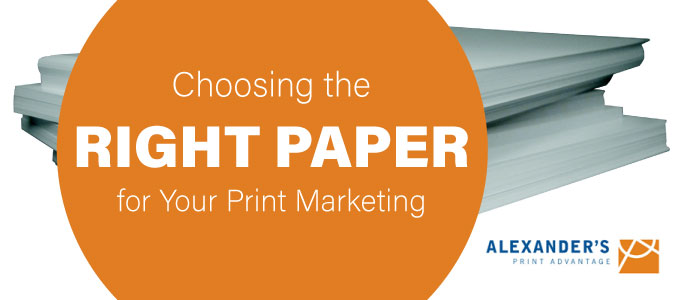Purpose
What is the purpose of this piece of marketing collateral? Is it to inform, motivate or persuade your customers? Is it a book, notepad, pen, flyer, brochure, business card, etc.? Keep the end result in mind. The purpose of the piece needs to drive the paper choice.
Lifespan
How durable does this piece need to be? Does it need to last several months, even years? Or just a few days or weeks? The needed lifespan of your piece will also influence and help determine what type of paper you will need.
Impression and Finish
What kind of impression do you want your piece to convey? Should it be seen as cheap and simple or luxurious and fancy? Metallics, foils and textured coatings, such as varnish and “soft touch,” offer an enhanced experience. These special coatings add a layer brilliance to printed collateral, and it is one that your audience is not going to forget.
There are three basic coatings that can be applied to paper aside from textured coatings: matte, gloss and dull. Matte stock paper is a non-glossy, flat look. They are good for printed pieces that require a subtle appeal. Gloss stock paper is paper with high sheen, much like what you would see in a magazine. Gloss stock is good for grabbing attention since the gloss makes the color on the paper pop. Dull stock paper is a smooth and low-gloss paper. It is the in between of gloss and matte.
Color, Opacity and Brightness
There are so many different colors of paper for each color. For example, white comes in white-blue, balanced white, soft white, etc. This is important when considering the color of the text and images on your printed piece because warm tones, like skin, would like greyish and sickly on white-blue paper.
Opacity refers to the “showthrough” of the print seen on the flipside of the shape. Think of how a book’s pages are opaque enough to be seen through when held up to light, like the sun. Does your printed piece need to avoid opacity?
Brightness influences the contrast of text and images to white space, and the readability and perception of the ink color. The brighter the paper, the more vivid and crisp looking the colors, letters, and images are. If your brand is all about muted tones, you might want to lower the brightness level to stay on-brand.
At Alexander’s we know how confusing it can be to have so many different types of paper to print on. We make sure to answer all of your questions. If you need a printer for your marketing collateral, call Alexander’s! Alexander’s can help you and/or your business from content creation to print and fulfillment. Call our office at 801-224-8666 or fill out the contact form below. Talk to you soon!


